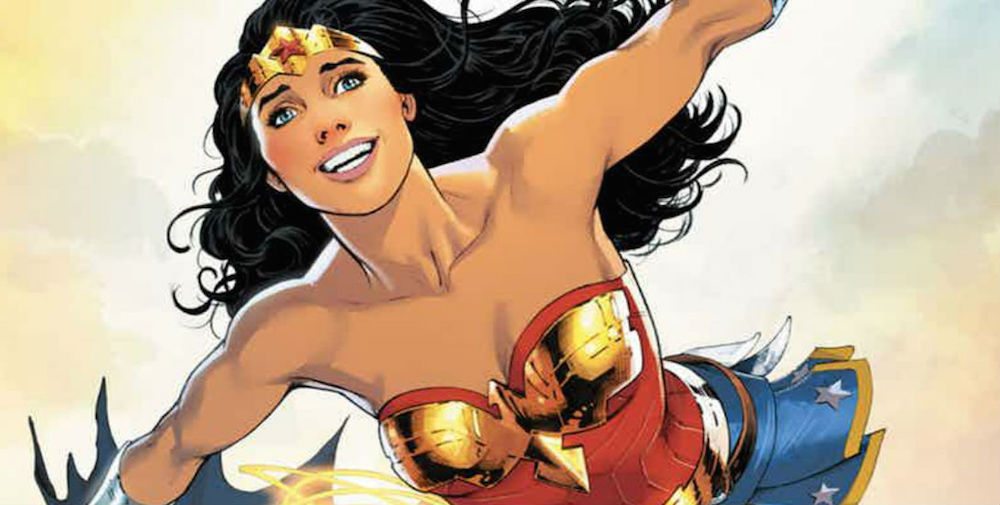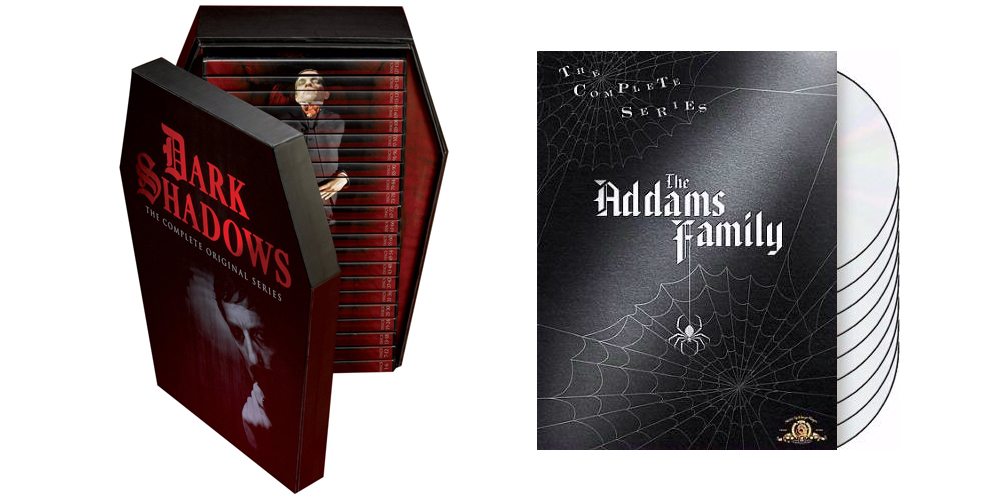
What better way to lead off a week loaded with excellent annuals than with the Wonder Woman Annual #1, which features the last published story (for now) by the team of Greg Rucka and Nicola Scott. They and their fellow creators do wonderfully by the Amazon Princess with one-and-done stories. The Annual would be a terrific comic for anyone who walks for the first time into a comic shop this week after having seen the movie.
There is also the finale of “The Lazarus Contract,” Guest-starring Deathstroke, in Teen Titans Special #1, a familiar villain shows up (again!) in Flash #23, and a relaxing lunch is interrupted by monster hunting in Trinity Annual #1.
WARNING: SPOILERS FOR ALL OF THIS WEEK’S DC COMICS BELOW.
Wonder Woman Annual #1 – Greg Rucka, Vita Ayala, Michael Moreci, Jackson Lanzing, Collin Kelly; Nicola Scott, Claire Roe, Stephanie Hans, David LaFuente, Artists; Romulo Fajardo Jr., Jordie Bellaire, John Rauch, Colorists
Ray – 9/10
Corrina: Great Tribute to Wonder Woman, Past and Present
Ray: When it comes to annuals, DC has a lot of different strategies, but their recent foray into using annuals as anthologies for a host of top-tier talents to tell stories with the character is working out really well. This annual features four strong ten-page short stories focusing on Wonder Woman and her compassion. The first is by the A-list regular creative team of Greg Rucka and Nicola Scott, and it’s essentially a lost story from “Year One,” focusing on the first time Diana met Batman and Superman and how they all came to trust each other. Rucka is one of the only writers to write all three members of the Trinity in their own titles, so there’s no weak spots here, just some great characterization and a good deal of humor in the interaction. Plus, brilliant art. The second story is one of three that deals with Diana showing compassion to monsters, and takes place in Markovia, as Diana tries to save King Shark from execution in Markovia for a crime he didn’t commit, in a story by Vita Ayala and BoP artist Claire Roe.
The third story, by Michael Moreci and Stephanie Hans, is a horror-accented story with brilliant, dreamlike art as Diana takes a trip to a remote Japanese village to do a favor for an old friend of Steve Trevor’s and help him put to rest a demon that has been terrorizing his village. The twist, however, is that the demon is his curse and he needs Diana to kill him if he gets out of control. Both bloody and touching, this is the fastest story of the four but is incredibly effective. The fourth story, by Joyride co-writers Lanzing and Kelly and Ultimate Spider-Man artist David LaFuente, is on the surface a Wonder Woman vs. Kaiju story, as a mysterious giant monster rises from the sea and becomes a target for ARGUS. However, Diana is able to see through the propaganda and realize the monster is essentially a scared child. Did you ever want to see Wonder Woman playing fetch with Godzilla? I didn’t know I did until now. A quartet of fun stories that nicely sum up what sets Diana apart from other superheroes. Highly recommended.

Corrina: For years, it seemed like creators did not “get” what made Wonder Woman special and unique, from the attempts to turn the Amazons into murderers and child slavers, to the need to make her more “relatable” and so on. (Of course, this is nothing new in the history of the Amazon Princess: see depowered version in the 1970s and the awful bondage costume from the 1980s. On second thought, skip them.)
But what this annual proves in with its variety of creative team is that, yes, Wonder Woman is unique and can be written to her strengths of intelligence and compassion. It’s no surprise that the first story by Rucka and Scott is note-perfect, from Clark knowing that they’re in big trouble for spying on Diana, to Batman answering, truthfully, that his name is “Batman.” I predict that whole page will soon become of the most famous pages in Wonder Woman lore. Add in Lois Lane actually doing her job (Superman title writers, take note) and that’s icing on the cake. Or maybe the cherry on top.
However, I approached the rest of the tales with concern. Would it be more of Princess McStabby Sword or not? Whew. Nope. The other tales beautifully take a particular aspect of the Amazon use different genres (political intrigue, supernatural horror, monster stories) to showcase her unique strengths. Also, I will never not like Wonder Woman saving King Shark or playing fetch with Godzilla.
Bravo, creators.
Teen Titans Special #1 – Priest, Dan Abnett, Benjamin Percy, Writers; Paul Pelletier Khoi Pham, Brett Booth, Pencillers; Andrew Hennessy, Wade Von Grawbadger, Norm Rapmund, Inkers; Adriano Lucas, Jim Charalampidis, Andrew Dalhouse, Colorists
Ray – 9/10
Corrina: Conclusion Is Compressed
Ray: This concluding chapter to the “Lazarus Contract” delivers amazing characterization for Deathstroke, excellent action, and several great twists – but is slightly marred by what strikes me as poor characterization for one of its players. The issue opens with Grant falling in with a group of young geniuses – later revealed to be agents of HIVE, who convince him to undergo the treatment that turns him into Ravager and eventually kills him. Deathstroke, meanwhile, is zooming through time and has finally caught up to Grant, but when he reveals his identity, it doesn’t go well. Seeing Grant as a Deathstroke fanboy is amusing, but it all falls apart when he finds out his assassin idol is his abusive father. Meanwhile, the Titans and Teen Titans are on Deathstroke’s trail, but they have a problem of their own – mainly a rude little Napoleon by the name of Damian Wayne. Between his disregard for Aqualad, his open contempt for Kid Flash, and his seeming desire to argue with everyone in sight, it’s hard to see how he qualifies as a halfway competent Teen Titans leader. Fortunately, even as Damian makes petty moves like ordering Wally left behind on a mission, the team has other allies – including Jericho, whose bond with the Titans seems to be slowly being restored.
I also liked the impromptu team-up between young Wally and Aqualad, as Damian’s two least-favorite members work together to join the fight and wind up getting a pep talk from their driver – Wintergreen. As an aside, this subplot isn’t a great look for Damian and I see a racial sensitivity intervention in his future, maybe. Damian’s no-good, terrible, very bad issue only gets worse when the team’s pursuit of Deathstroke leads them to find younger versions of themselves in the timestream, and Damian’s response is to temporarily kill Wally to disrupt Deathstroke’s connection to the Speed Force. Deathstroke winds up trapped in the Speed Force, and young Wally insists on performing a daring move with his counterpart to get him back. In the aftermath, Deathstroke retires as an assassin after what he saw in there (interesting), Damian fires Wally from the TT (Bad. I hope the rest of the team walks.), and older Wally finds out that he has permanent heart damage from Damian’s attack when he was younger. Great job, Bat-kid. Overall, a great issue that sets up a ton of interesting plots, but jeez, this Damian…

Corrina: I felt since the beginning of this Teen Titans run, superior as it is to the last decade of Teen Titans, that there was far too much emphasis on Damian Wayne, from using him as the inciting character to concentrating on his foes in the early issues. The thing with Damian’s actions this time is that he hasn’t moved forward at all from the person who kidnapped his team of Titans to prove a point. Remember that? And remember how they all worked together against Ra’s and the rest to win? That was whole point of the first arc, to prove to Damian that his teammates could handle themselves and he should start trusting them.
Damian obviously learned zilch or the creative team forgot that he was supposed to learn something about the value of teamwork. He’s simply a loose cannon in this story and everything he does detracts from the focus on Deathstroke and the hard decisions to be made about who can be saved or who’s not redeemable.
Damian’s dominance, sadly, also takes away from younger Wally’s decision (and personal growth) in not letting someone suffer, even Slade Wilson. It also colors Slade’s decision to stop being Deathstroke, which is a huge takeaway from the character. Hopefully, Priest will follow that up in Deathstroke’s own book.
It’s been a fine crossover but Damian’s behavior, as written, would have me seriously consider dropping the Teen Titans title, if I didn’t receive review copies.
Trinity Annual #1 – Rob Williams, Writer; Guillem March, Artist; Tomeu Morey, Colorist
Ray – 7.5/10
Corrina: Giant Demon? Um, Okay.
Ray: This annual by the upcoming guest creative team of Superman: Action Comics, Rob Wiliams and Guillem March, is a decent fill-in story featuring the return of one of my favorite more-obscure DC characters. The story picks up directly from the events of the recent Trinity of Evil story, which brought Ra’s Al Ghul, Circe, and a skeptical Lex Luthor together to take control of the mysterious Pandora Pools, magical siblings to the Lazarus Pits. Ra’s and Circe are all in on their plan, although Ra’s is skeptical. Meanwhile, Bruce has gathered Clark and Diana at one of his restaurants so they can spend a little time together out of costume. These segments are the issue’s best, but quiet time is naturally not going to last long. They soon get a distress call as a mysterious and ancient figure is making his way towards the Pandora Pita. The cloaked figure makes quick work of Ra’s Al Ghul’s guards and reveals himself – as Jason Blood.
I was a huge fan of Jason Blood – and Etrigan – in the New 52 series Demon Knights by Cornell and Venditti, one of DC’s most enjoyable surprises in recent years, so it’s great to see him back here. However, his assault on the sanctuary leads to his blood being exposed to the pits, which has an unexpected effect – it splits Jason and Etrigan into two separate beings again. While Jason becomes an old man, aging quickly as his centuries of immortality catch up with him, Etrigan is unbound and becomes a giant monster, leading to the issue’s big action segment as Batman, Superman, and Wonder Woman are massively outmatched against his demon army. Etrigan without Jason’s influence is a flat-out villain, so part of the story is based around trying to convince Jason Blood that he has to take back the burden of the demon. It’s not a groundbreaking story, but it’s a good one for fans of the Trinity, or DC’s magical corner. Not sure what to make of the reveal at the end that the Red Hood and the Outlaws crew is involved here, though.

Corrina: There are many good elements in this story: the trio’s dinner out together, the action sequences, and the conversations between Luthor, Circe and Ra’s. Unfortunately, these elements don’t form a coherent whole. Instead, the tale reads like the character of Pandora herself: shifting focus for the needs of whatever plot must be put into play.
Why Etrigan is near the Pandora Pools is not explained, save that he’s mystical and so are they. Nor is it explained why the Pools would make Demon Etrigan into a giant, other than it’s cool, I suppose, to see Wonder Woman, Superman, and Batman fighting a giant, rhyming demon. And I have read the whole “split them up, nope, Jason takes Etrigan back,” element in numerous Demon stories. It seems to be the go-to thing to happen with the Demon and, thus, Jason’s angst and pain had little impact on me.
Making the story even more muddled is the ending surprise, which brings in the other “Trinity” group, Red Hood (Batman-type), Artemis (WW-type), and Bizarro (Superman-type) into the story. It comes out of left field and, again, seems unconnected to whatever is being planned. Nice moments but the story doesn’t gel.
The Flash #23 – Joshua Williamson, Writer; Carmine Di Giandomenico, Artist; Ivan Plascencia, Colorist
Ray – 8.5/10
Corrina: Old School Team-Up
Ray: This is overall a very strong issue with great characterization for both Barry and guest-star Hal Jordan, but the main plot really drives home just how little death means in comics these days. The issue opens with a visit to the Flash museum in the 25th century, as it closes in on the exhibit of Eobard Thawne’s costume – and reveals that apparently Thawne was the Flash’s best friend. Of course, as we know, Thawne is dead, something Barry has trouble accepting. Barry’s odd behavior since the events of “The Button” is starting to show to various people, including the workers at the morgue, and more importantly his friends and family. Meanwhile, Barry forgets his own birthday and is surprised by Iris. However, he’s distracted, something Iris quickly notices. What she doesn’t realize is that he’s having visions of Thawne showing up and killing everyone he loves.
Hal shows up for Barry’s birthday, complete with a gift Barry got him several years back – they’re both distracted by current events, which just goes to show how good Williamson is at writing the friendships between heroes and how their jobs affect them, as we saw in “The Button.” Barry is about to have a falling-out with Iris over how distracted he is, but that’s interrupted by an attack by Multiplex, in full-on rejected Nice Guy mode. Seeing Hal and Barry in action together against a powerful villain with great visuals is a lot of fun, but really, the strength here is in the dialogue more than anything. And the cliffhanger, which has Thawne showing up to target Iris and Wally in their home, makes me wonder what the whole point of killing him in “The Button” was. Still, a great issue, even though comic death is a revolving door that never stops killing. Doctor Manhattan’s lost some of his mojo. New hope for Rorschach?
Corrina: Classic Silver Age Barry forgetting the time, plus forgetting his birthday? Check. Classic Hal arrival to save him from his own confusion? Check. Classic Silver Age idiocy in Barry refusing to tell Iris that he’s the Flash? Also, check. The first two are terrific. The third, however, shows off how ridiculous this trope is because, hey, Iris already knows about her nephew’s powers, which means she is a target for villains already, and in on the loop of superhero knowledge too. Is she somehow less reliable about Barry’s secret identity than Wally himself?
I’m not sure why creators love this trope so much but Williamson has been so good in this run that I have hopes he’ll resolve this issue soon.
As for the story, it’s hard to tell if Barry’s visions of Thawne killing everyone are flashes of the future or simply Barry’s fears. But then Multiplex strikes and it’s a great fight. I wonder why Multiplex isn’t usedmore often? He’s not one of the established Rogues but he should be. Or maybe I just have a secret thing for multiple men. (Hello, Jamie Madrox!)
Meanwhile, because Iris is ignorant of Barry’s true identity, it’s easy for Thawne to surprise her. Gah. He didn’t stay dead long, did he? Or is it an earlier version of Thawne? No, it seems clear from the earlier parts of the issue that he’s regenerated. Maybe he can tell Barry what he saw in the time stream? One can hope that mystery may be resolved soon, also.
Disclaimer: GeekDad received these issues for review purposes.




